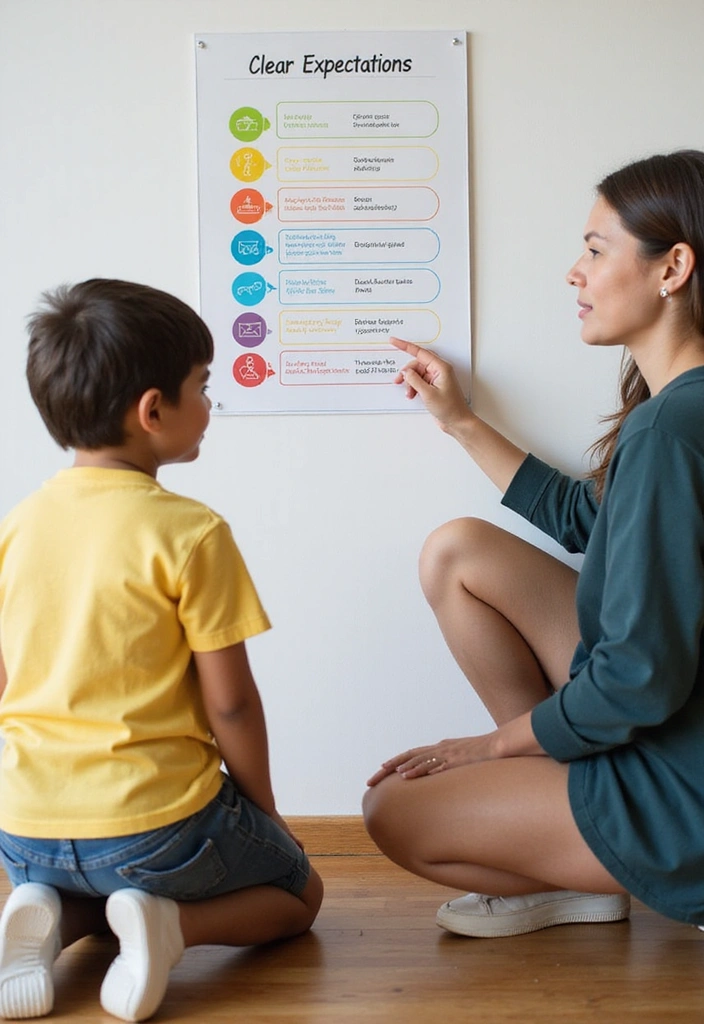Tired of ineffective discipline? Discover 17 proven behavior management strategies that actually work for real results! Reduce meltdowns and foster cooperation. You’ll love tip #8!

If you’re a parent, you know that behavior management can sometimes feel like an uphill battle. Kids are curious, energetic, and sometimes downright defiant. But don’t worry—you’re not alone!
This article is packed with 17 effective behavior management strategies designed to help you navigate those tricky moments with ease. From simple techniques that foster positive communication to creative solutions that encourage responsibility, these tips will transform your parenting approach.
The best part? You’ll want to try these methods right away, especially #8, which could change everything for you and your child. Let’s dive in!
1. Positive Reinforcement

Positive reinforcement is a powerhouse strategy that involves rewarding desirable behavior to encourage its recurrence. Whether it’s a sticker chart or verbal praise, acknowledging good behavior gives children the motivation they need to continue being their best selves.
Try these tips:
– Set clear expectations: Kids should know what behaviors are expected.
– Use a rewards system: Create a fun chart to track progress. Each sticker or mark can lead to a small reward.
– Celebrate achievements: Don’t forget to celebrate both small and big wins!
The goal is to build their confidence and show them that positive behavior is recognized and appreciated.
2. Consistent Routine

Establishing a consistent daily routine can work wonders for behavior management. Kids thrive on predictability; having a set schedule helps them feel secure and reduces anxiety.
Here’s how to get started:
– Create a visual schedule: Use pictures to illustrate daily tasks, making it easier for younger kids to understand.
– Stick to it: Try to keep the same routines daily, including mealtimes, playtimes, and bedtimes.
– Involve your child: Let them help in creating the routine—this makes them more invested.
When kids know what to expect, they are less likely to act out. It’s a simple but effective way to improve their behavior.
3. Time-Outs Done Right

Time-outs often get a bad rap, but when used correctly, they can be an excellent tool for behavior management. The key is to make time-outs a calm and reflective experience rather than a punishment.
Here’s what to do:
– Choose a quiet spot: Create a designated area where your child can take a break when emotions run high.
– Keep it short: Time-outs should be brief. A general rule is one minute for each year of age.
– Talk it out: Once they’ve calmed down, discuss the behavior that led to the time-out.
This way, you’re not just isolating them but helping them understand their feelings and actions.
4. Open Communication

Fostering open communication with your child enhances their emotional intelligence and encourages them to express feelings instead of acting out. Kids who can articulate their feelings are less likely to resort to negative behaviors.
Consider these strategies:
– Practice active listening: Show them you care by giving them your full attention when they speak.
– Use open-ended questions: Encourage your child to share their thoughts by asking questions that require more than yes or no answers.
– Validate their feelings: Let your child know that it’s okay to feel angry or sad; acknowledging their feelings can diffuse a lot of tension.
By creating a safe space for dialogue, you empower your child to communicate more effectively.
5. Set Clear Boundaries

Setting clear and consistent boundaries helps children understand what’s acceptable and what isn’t. Without boundaries, kids may feel overwhelmed and test limits to see how far they can go.
Here are a few tips:
– Establish household rules: Collaborate with your child to create a list of family rules that everyone agrees on.
– Be consistent: Consistency reinforces boundaries. If a rule is broken, apply the same consequences each time.
– Be clear and concise: Use language that’s easy for your child to grasp to communicate your expectations.
The more structured the environment, the more comfortable your child will feel.
6. Model Desired Behavior

Children learn by example. Modeling the behavior you want to see is one of the most powerful behavior management strategies you can employ.
Here’s how to do it effectively:
– Display the behavior: Show empathy, patience, and kindness in your interactions.
– Talk about your feelings: Share how you manage frustration or sadness. This teaches your child emotional regulation.
– Involve them in problem-solving: When faced with challenges, invite your child to brainstorm solutions alongside you.
When they observe positive behavior regularly, they’re more likely to emulate it. This strategy creates a positive cycle of learning.
7. Encourage Independence

Fostering independence can greatly influence a child’s behavior positively. When kids feel capable, they’re less likely to act out.
Consider these methods:
– Assign age-appropriate chores: Responsibility helps kids feel valued and teaches them accountability.
– Allow choices: Give your child options in simple decisions, making them feel empowered.
– Praise self-sufficiency: Recognize their efforts in completing tasks on their own, no matter how small.
This approach not only improves behavior but also builds confidence and problem-solving skills.
8. The Power of Play

Play is not just fun; it’s a powerful tool for behavior management. Engaging in play helps children learn social skills, problem-solving, and emotional regulation.
Here’s how to integrate play into behavior management:
– Use role-playing: Create scenarios that encourage empathy by allowing kids to step into someone else’s shoes.
– Incorporate games: Choose games that promote teamwork and communication, helping to build relationships and trust among peers.
– Make it interactive: Activities like arts and crafts or building projects can teach patience and collaboration.
By utilizing play, you address behavioral issues in a natural way that feels enjoyable and productive.
9. Use Humor

Sometimes, a little humor can diffuse tension faster than any other method. Laughter can lighten the mood and help children absorb lessons without feeling lectured.
Here’s how to use humor effectively:
– Make light of mistakes: Instead of scolding, find the humor in a situation; it can reduce defensiveness.
– Use funny voices or characters: Make daily tasks more enjoyable by adding a playful twist.
– Share funny stories: Relate amusing anecdotes from your own childhood to create a bond.
Humor creates a positive environment, making it easier for children to accept guidance.
10. Stay Calm

In the heat of the moment, it’s crucial for parents to remain calm. Your emotional state sets the tone for the entire interaction.
Consider these techniques:
– Take deep breaths: Before responding to a challenging behavior, pause and inhale deeply to regain composure.
– Count to ten: This classic technique allows you to gather your thoughts before reacting.
– Use a calm tone: Speak softly but firmly, letting your child know you mean business without escalating the situation.
Staying calm helps you model emotional regulation, teaching kids how to handle their feelings more effectively.
11. Offer Choices

Giving children choices empowers them and teaches them decision-making skills. Instead of simply dictating behavior, offering options makes them feel included.
Here’s how to implement it:
– Keep it simple: Offer two or three options to prevent overwhelming them. For example, ‘Would you like to wear the blue shirt or the green one?’
– Make it relevant: Choices should be related to the current situation, whether it’s what snack to eat or which game to play.
– Encourage them to express preferences: Allow them to share why they choose one option over another.
This approach can reduce resistance and help cultivate responsibility.
12. Implement Natural Consequences

Allowing natural consequences to occur can be an effective way to teach responsibility. When children experience the outcomes of their actions, they learn valuable lessons.
Here’s how to approach it:
– Discuss potential consequences: Before an action, explain what might happen if they don’t follow rules, allowing them to make informed choices.
– Step back and observe: Let them face the consequences without stepping in immediately to save the day.
– Reflect afterward: Once the situation has passed, discuss what happened and how they felt.
This approach encourages critical thinking and helps them connect choices with results.
13. Use Visual Cues

Visual cues are a great way to reinforce behavior expectations, especially for younger kids. Pictures and symbols can make it easier for them to remember rules and routines.
Here’s how to use visual cues effectively:
– Create a behavior chart: Use images that represent positive behaviors, like sharing or helping. Each time they display that behavior, they can check off or color it in.
– Use color codes: Assign colors to different behaviors or moods, helping children understand their emotions visually.
– Encourage creativity: Let them create their own visual reminders to reinforce what they’ve learned.
Visual cues simplify communication and help kids internalize expectations.
14. Build a Support Network

Building a support network of family and friends can be incredibly beneficial in managing behavior. When you have a team behind you, it helps maintain consistency and provides emotional support.
Some ways to build this network include:
– Share strategies with others: Discuss what works for you with other parents or caregivers so everyone is on the same page.
– Attend parenting groups: Join community groups or online forums to exchange ideas and experiences.
– Don’t hesitate to ask for help: Whether it’s babysitting or advice, having a solid support system is key.
Having a network can make a huge difference in your parenting journey.
15. Teach Problem-Solving Skills

Teaching problem-solving skills equips children with the tools they need to handle conflicts and challenges. This reduces emotional outbursts and fosters independence.
Here’s how you can teach these skills:
– Break down problems into smaller parts: When faced with a dilemma, guide your child to analyze it step by step.
– Encourage brainstorming: Let them come up with different solutions to a problem and weigh the pros and cons of each.
– Role-play scenarios: Use role-play to practice navigating potential challenges.
These skills not only help in behavior management but prepare them for future real-world situations.
16. Encourage Empathy

Empathy is a cornerstone of emotional intelligence. Teaching children to understand and share the feelings of others can dramatically reduce challenging behaviors.
Consider these methods:
– Read stories together: Discuss the emotions of characters and how their decisions affect others.
– Volunteer as a family: Engage in community service projects together to foster a sense of compassion.
– Use “feelings” vocabulary: Encourage your child to express their feelings verbally and to recognize emotions in others.
When children learn empathy, they become more considerate, resulting in improved relationships and behavior.
17. Acknowledge Your Own Emotions

As a parent, it’s essential to recognize and manage your own emotions. Children are incredibly perceptive; they can sense your feelings even if you don’t vocalize them.
for acknowledging your emotions include:
– Self-reflect: Take time to understand your feelings and how they influence parenting decisions.
– Share feelings: Be open about your emotions with your children, modeling healthy emotional expression.
– Seek support: Don’t hesitate to reach out for help when feeling overwhelmed.
By managing your emotions, you create a stable environment that encourages positive behavior in your child.
Finally

Implementing these 17 behavior management strategies can make a significant difference in your parenting journey. Each method is designed to help you connect with your child and foster an environment of understanding and support.
Try out these techniques, and you might find that your daily interactions with your child become smoother and more enjoyable. Parenting is a growing experience for both you and your child, and these strategies can help you along the way.







